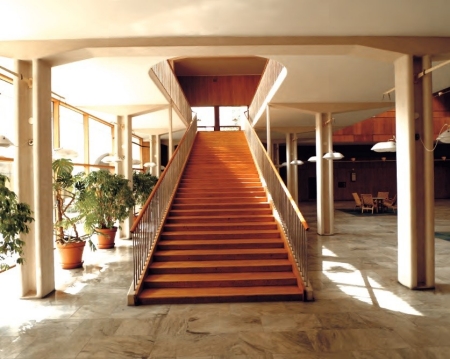With his addition to Nicodemus Tessin’s heavily renovated seventeenth-century building, Asplund made the Gothenburg Courthouse speak a modern language of the law. Typically, critics have explained the large plate-glass inner facade and light-filled interior hall of the extension as embodying the values of the Social Democratic party (the ruling partner in the Swedish governmental coalition elected in 1932), its “everyday” character echoing socialist interest in demystifying both the law and the state. Interpretation of the traditional elements of the building varies. Some critics claim they have to do with the representational character of the site; some emphasize Asplund’s bourgeois background; still others assert his inability to shed his traditional architectural education. Most recently the design has been seen as a scenario of clashing urban and political visions (Stockholm versus Gothenburg). I argue instead that Asplund’s collage of modernist and traditional elements springs from an opposite dynamic: his effort to reconcile the complex cultural forces within Sweden during the 1930s. A more searching and balanced analysis also brings Asplund’s imaginative genius into sharper relief and reveals him as one of the first architects to represent simultaneously the modernity and the traditional sovereign authority of the state.
Gothenburg was not alone in struggling with the problem of modernity and public architecture in the interwar period, and this context was the focus of my work at CASVA. Willem Dudok’s Town Hall in Hilversum (1928 – 1931) was the most influential public building of the period built in the modern style. Dudok’s attitude toward the relation between history and modernity was particular: no effort should be made to blend the two. It was, rather, in their contrast that the values of each were revealed. Asplund probably learned little from Dudok. Le Corbusier’s League of Nations proposal (1927), however, had attempted to combine modernity and tradition. Denied victory in the competition, Le Corbusier publicized his project extensively, notably in his book Une maison — un palais: À la recherche d’une unité architecturale (1929), in which he showed how traditionally modest forms could express high representational values. Le Corbusier’s work echoes through Asplund’s design, not just in forms but in his reinterpretation of Le Corbusier’s promenade architecturale in symbolic terms.
Construction of the extension also took place at a time of national debate about the law, as many in the legal profession placed new emphasis on the psychological and sociological roots of crime, in contrast to abstractions of good and evil. The socialists, for example, wrapped their reforms in the mantle of nationalism. In a speech delivered on May Day, 1933, the Social Democratic premier Per Albin Hansson equated modernization of the law with the highest patriotic and historic virtues of the country. Thus Asplund’s combination of tradition and modernity does not assert that social democracy can be equated with modernism; rather, it accurately reflects contemporary social democratic tactics and legal values. It was the reconciliation of these cultural and political tensions that stood at the center of Asplund’s task and is reflected in the visitor’s experience of the building.
Members' Research Report Archive
Public Buildings and Hygienic Workrooms: Gunnar Asplund’s Courthouse Extension in Gothenburg, Sweden (1934–1938)
Nicholas Adams, Vassar College
Paul Mellon Visiting Senior Fellow, fall 2011
My book in preparation focuses on the Courthouse Extension in Gothenburg, Sweden, by Gunnar Asplund (1885–1940) and sets it in relation to other public buildings in Sweden and the rest of Europe in the interwar period. During my two months at

Gunnar Asplund, Courthouse Extension, Gothenburg, Sweden, 1934 – 1938, staircase. Author photograph